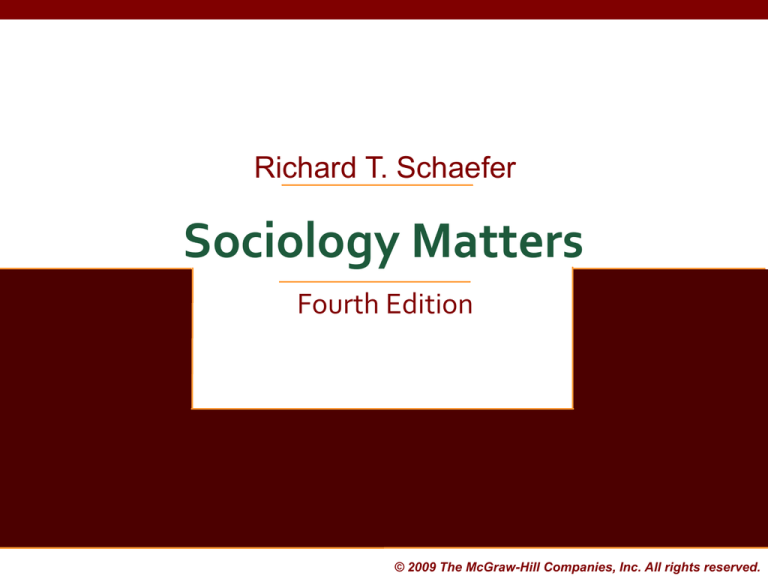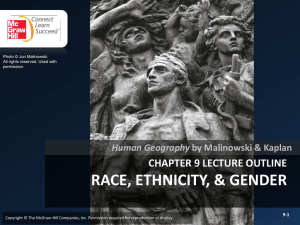
Richard T. Schaefer
Sociology Matters
Fourth Edition
© 2009 The McGraw-Hill Companies, Inc. All rights reserved.
Slide 2
Inequality by Race and Ethnicity
█
█
█
█
█
The Privileges of the Dominant
The Social Construction of Race and Ethnicity
Immigration and New Ethnic Groups
Explaining Inequality by Race and Ethnicity
Patterns of Prejudice and Discrimination
© 2009 The McGraw-Hill Companies, Inc. All rights reserved.
Slide 3
The Privileges of the Dominant
█
One aspect of discrimination often
overlooked is privileges dominant groups
enjoy at expense of others
– McIntosh:
•
•
•
•
Rarely needed to step out of comfort zone
Skin color (white) opened doors
Whiteness made job of parenting easier
Others did not evaluate her in racial terms
© 2009 The McGraw-Hill Companies, Inc. All rights reserved.
Slide 4
The Privileges of the Dominant
█
Racial formation: sociohistorical process in
which racial categories are created, inhibited,
transformed, and destroyed
– Social construction of race: process of
defining a group as a race based in part on
physical characteristics as well as historical,
cultural, and economic factors
© 2009 The McGraw-Hill Companies, Inc. All rights reserved.
Slide 5
The Privileges of the Dominant
█
Stereotypes: unreliable generalizations
about members of group that do not
recognize individual differences
Racial group: minorities set apart from
others by obvious physical differences
█ Ethnic group: Set apart from others
primarily because of its national
origin or distinctive cultural patterns
█
© 2009 The McGraw-Hill Companies, Inc. All rights reserved.
Slide 6
Race
█
Each society determines which
“obvious” differences are
important while
ignoring others
– Racial and ethnic
composition of U.S.
population will change
more in next 100 years
than in the last 100
© 2009 The McGraw-Hill Companies, Inc. All rights reserved.
Slide 7
Table 6-1: Racial and Ethnic Groups in
the United States, 2006
© 2009 The McGraw-Hill Companies, Inc. All rights reserved.
Slide 8
Figure 6-1: Racial and Ethnic Groups in the
United States, 1500-2100 (Projected)
© 2009 The McGraw-Hill Companies, Inc. All rights reserved.
Slide 9
Ethnicity
█
Ethnic group: Set apart from others primarily
because of its national origin or distinctive
cultural patterns
– Distinction between racial
and ethnic minorities not
always clear-cut
– Distinction between
racial and ethnic groups
is socially significant
© 2009 The McGraw-Hill Companies, Inc. All rights reserved.
Slide 10
Immigration and
New Ethnic Groups
█
Significant segment of population of U.S.
made up of White ethnics whose ancestors
arrived from Europe
– Symbolic ethnicity: emphasis on concerns such
as ethnic food or political issues rather than
deeper ties to one’s ethnic heritage
© 2009 The McGraw-Hill Companies, Inc. All rights reserved.
Slide 11
History of Immigration
█
Contemporary diversity of U.S. reflects
centuries of immigration
– 1920s: preference to people from western Europe
– Late 1930s and early 1940s: allowed Jewish
refugees to escape Nazi regime
– Since 1960s: policies encourage immigration of
people who have relatives in U.S. or those who
have needed skills
– Immigration Reform and Control Act of 1986
© 2009 The McGraw-Hill Companies, Inc. All rights reserved.
Slide 12
Figure 6-2: Legal Migration in the
United States, 1820-2010
© 2009 The McGraw-Hill Companies, Inc. All rights reserved.
Slide 13
Functions of Immigration
█
Immigration performs valuable functions
– For receiving society:
• Alleviates labor shortages
– For sending nation:
• Can relieve economies unable to support large
numbers of people
– Dysfunctions:
• Areas with high concentration of immigrants may not
meet short-term social needs
• Loss of skills to developing countries
© 2009 The McGraw-Hill Companies, Inc. All rights reserved.
Slide 14
The Conflict Approach
to Immigration
█
█
White ethnics and racial minorities often
antagonistic toward one another because of
economic competition
Theorists note how much of debate over
immigration phrased in economic terms
© 2009 The McGraw-Hill Companies, Inc. All rights reserved.
Slide 15
Explaining Inequality
by Race and Ethnicity
█
Functionalist Perspective
– Nash’s 3 functions that racially prejudiced
beliefs provide to the dominant group:
• Moral justification for maintaining
unequal society
• Discourage subordinate groups from questioning
their status
• Encourage support for the existing order
© 2009 The McGraw-Hill Companies, Inc. All rights reserved.
Slide 16
Explaining Inequality
by Race and Ethnicity
█
Functionalist Perspective
– Rose identified dysfunctions associated with
racism
• Society that practices
discrimination fails
to use resources
of all individuals
• Discrimination aggravates
social problems
• Society must invest time
and money
to defend barriers to
full participation
• Racial prejudice undercuts
goodwill and diplomatic
relations between nations
© 2009 The McGraw-Hill Companies, Inc. All rights reserved.
Slide 17
Explaining Inequality
by Race and Ethnicity
█
Conflict Perspective
– Exploitation theory: Racism keeps minorities
in low-paying jobs and supplies the dominant
group with cheap labor
• Too limited to explain prejudice in its many forms
– Racial profiling: Arbitrary action initiated
by an authority based on race, ethnicity,
or national origin rather than on
person’s behavior
© 2009 The McGraw-Hill Companies, Inc. All rights reserved.
Slide 18
Explaining Inequality
by Race and Ethnicity
█
Interactionist Perspective
– Contact hypothesis: interracial contact
between people of equal status in cooperative
circumstances will cause them to become less
prejudiced and to abandon old stereotypes
© 2009 The McGraw-Hill Companies, Inc. All rights reserved.
Slide 19
Table 6-2: Sociology
Perspectives on Race
© 2009 The McGraw-Hill Companies, Inc. All rights reserved.
Slide 20
Patterns of Prejudice
and Discrimination
█
Prejudice: Negative attitude toward an
entire category of people
– Ethnocentrism: Tendency to assume one’s
culture and way of life are superior to others
– Racism: Belief that one race is supreme and
others are innately inferior
– Hate crime: Criminal offense committed because
of the offender’s bias against a race, religion,
ethnic group, national origin, or sexual orientation
© 2009 The McGraw-Hill Companies, Inc. All rights reserved.
Slide 21
Color-Blind Racism
█
Color-blind racism: Use of principle
of race neutrality to define racially
unequal status quo
– Idea that society should be color-blind only
perpetuates racial inequality
– Color line is still in place, even if more people
refuse to acknowledge its existence
© 2009 The McGraw-Hill Companies, Inc. All rights reserved.
Slide 22
Discriminatory Behavior
█
Discrimination: denial of opportunities and
equal rights to individuals and groups based
on some type of arbitrary bias
– Discrimination persists even for educated
and qualified minority members
Glass ceiling: invisible barrier blocking
promotion of qualified individuals in
work environment because of
gender, race, or ethnicity
© 2009 The McGraw-Hill Companies, Inc. All rights reserved.
Slide 23
Figure 6-3: Categorization of
Reported Hate Crimes, 2005
© 2009 The McGraw-Hill Companies, Inc. All rights reserved.
Slide 24
Figure 6-4: U.S. Median Income by
Race, Ethnicity, and Gender
© 2009 The McGraw-Hill Companies, Inc. All rights reserved.
Slide 25
Institutional Discrimination
█
Institutional discrimination: denial of
opportunities and equal rights that results
from operations of a society
– Affirmative action: positive efforts to recruit
minority members or women for jobs,
promotions, and educational opportunities
© 2009 The McGraw-Hill Companies, Inc. All rights reserved.
Slide 26
Measuring Discrimination
█
Comparing income data
– White men earned 40% more money
than Black men in 2006
– Black women earned significantly less
than White women
– Highly educated Asian Americans trail
well behind their White counterparts
© 2009 The McGraw-Hill Companies, Inc. All rights reserved.
Slide 27
Table 6-3: Median Income by Race and
Sex, Holding Education Constant
© 2009 The McGraw-Hill Companies, Inc. All rights reserved.









